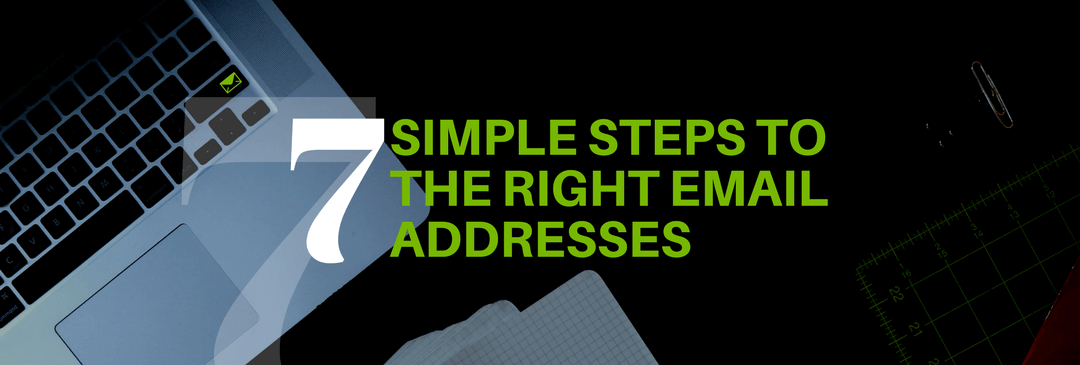
Expert Speak: How Does Email Appending Exactly Work
Author: Aaron Smith
It is a question so frequently asked, and yet so misinterpreted. So, how does email appending work? Let’s clear this once and for all!
Email appending is the gap-filler for your database. But don’t confuse it with data cleansing. It optimizes your B2B database by adding new information or by removing irrelevant columns but it DOES NOT select erroneous contacts individually and repair them. On the contrary, email appending manages your database on a field-by-field basis.
Purpose of Email Appending:
Updating Information: It replaces all the information in a field with its latest versions, matched from an external master database.
Adding New Information: New data fields can be added to the existing database, matching each data in the new field with corresponding entries in the database.
It takes 7 simple steps to successfully complete an email appending process:
- STEP I: Send your database to a data service provider
- STEP-II: Standardization of received data
- STEP III: Your database is matched with a master file
- STEP IV: Update mismatches and scrub erroneous entries
- STEP V: Send opt-in requests
- STEP VI: Remove opt-outs, thorough cleansing before delivery
- STEP VII: Receive appended and fully updated database
Maximum Email Appending. Minimum Data Spend. See Lake B2B’s 7-Step Process – in Action!
Of course, you can follow these steps on your own too. But frankly, your business can do better without spending valuable time and resources behind redundant data maintenance jobs. Especially, when there are specialists out there with expertise in data appending services.
7 Simple Steps to Optimize Email Appending for Better ROI
STEP I: Send your database to a data service provider
Email appending is a sophisticated procedure and needs experience hands in dealing with huge databanks. Hence, an appending service provider (probably one with email marketing also as one of their aligned services) is the best choice for speedy and hassle-free execution.
Tip:
- Never send the master file for appending.
- A file’s appending threshold is maximum of 2 years. It is very hard to match existing data to the new data being added beyond that point. (A B2B database decays over 25% per year.)
Additional Read: What Is Email Appending? Definition and Best Practices
STEP-II: Standardization of received data
This part of the process helps in increasing the match rates. The appending service provider standardizes the received database, including the company name. Duplicate records are removed via advanced data hygiene processes. Incorporating this process at the very beginning ensures efficient results and cleaner, safer data.
STEP III: Your database is matched with a master file
Email domains for respective companies where your contacts currently work are identified. Most service providers have a reference table that allows them to determine the naming convention used by the domain. Then the desired contact is retrieved by following the naming convention and the specific domain of employers.
Tip:
- More the number of fields in the pre-append database, the better the match. It helps if the following fields are present: “First Name”, “Last Name”, “Company Name”, “Street Address”, “City”, “State”, and “Zip Code”.
STEP IV: Update mismatches and scrub erroneous entries
Appending of large B2B databases requires automation. The crude matching of the tools often leaves rough edges in terms of mismatches and erroneous entries lying in the database. Even the old data contains errors that need to be corrected in order to achieve a successful appending operation. This is where expert hands play their part.
Data experts, with their specific skill-sets, locate and extract the errors. Afterward, they run cleansing tests on the overall database to verify the success of the operation.
Tip:
- Beware of service providers who offer “excellent match rates” before seeing your database.
STEP V: Send opt-in requests
However accurate the database is, it still misses one crucial ingredient for activation: recipient permission. Database providers assist you in launching opt-in (or double opt-in, as applicable) campaigns. There is nothing like an already “opted-in” list. But then, an ideal opted-in list is also a myth. Every list needs to be re-opted whenever it has undergone changes resulting in new information being added.
The process to achieve this successfully is to send a welcome email on your behalf to the updated list. Apart from getting opt-ins, this fulfills four other purposes:
- Confirms deliverability of your appended database
- Increases your audience base
- Gets you on the reader’s radar
- Maintains data hygiene
Tip:
- Beware of data providers who promise opted-in lists during list acquisitions.
Know More about Lake B2B’s Extensive Data Validation Process Before Compiling!
STEP VI: Remove opt-outs, thorough cleansing before delivery
There must be another round of data cleansing before the final delivery. It may look like duplicated efforts, but maintaining this flow is essential to guarantee the highest accuracy and relevance for your database. Top-notch data service providers include both pre-and post-append data quality checks, in their appending services.
Tip:
- Ensure that your own team does a quality check on the data before delivery. A simple way to do that is to ask for a sample list from the finished set and launch a mock campaign.
Additional Read: Ensure Your B2B Data Appending Includes Decay Protection!
STEP VII: Receive appended and fully updated database
Once sure about the quality of the database, fix the format for delivery that is more suited to your CRM and other integration tools. The common formats are CSV, XLS, and TXT. Service providers generally link you to a portal for receiving the updated file.
The 7-step process can be replicated for other broader data appending categories like phone and contact append, social media append, IP append, reverse email append, SIC/NAICS append, and more.
Found this useful? Share with your peers. Tell us if we missed something, in the comments below. Want your list appended from Lake B2B? Contact our expert data consultants right now!
Find more great insights on marketing and business data on our e-newsletter. Subscribe below!





